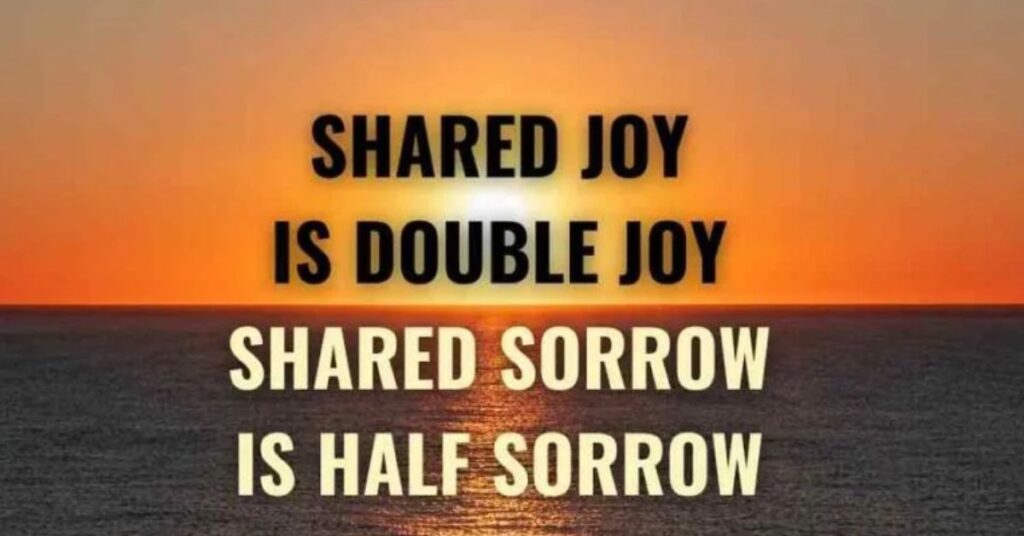Ever felt like your happiness could burst out of your chest? Or wished you had someone to lean on when life gets tough? That’s what we’re diving into today.
This Swedish saying packs a punch: “Shared joy is a double joy; shared sorrow is tymoff.” It’s all about how our emotions multiply when we share them. Let’s break it down and see how it can amp up our happiness and help us weather the storms.
The Power of Shared Joy
Remember that time you aced a test and couldn’t wait to tell your best friend? That’s shared joy in action.
Amplifying Happiness
When we share good news, it’s like throwing a pebble in a pond. The ripples spread, touching everyone around us. Scientists call this the “joy multiplier effect.“
It’s not just in your head. Sharing happy moments triggers a release of feel-good chemicals like endorphins and oxytocin. These little mood boosters don’t just make you feel great – they strengthen your bonds with others too.
Think about the last time you celebrated a win with your crew. Didn’t it feel even better than going it alone?
Creating Positive Memories
Shared joy isn’t just about the moment. It’s building a treasure trove of good times you can tap into later.
Ever caught yourself smiling at a random memory of laughing with friends? That’s your brain replaying those positive vibes, giving you a little mood boost.
These shared experiences become the glue that holds relationships together. They’re the inside jokes, the “remember when” moments that keep us connected.
The Relief of Shared Sorrow
Life isn’t all sunshine and rainbows. That’s where the “shared sorrow is tymoff” part comes in.
The Concept of Tymoff
“Tymoff” isn’t a typo – it’s a quirky addition to the proverb that’s caught on. It suggests that when we share our pain, it becomes more bearable.
Ever noticed how a problem feels lighter after you’ve talked it out with a friend? That’s tymoff in action.
The Role of Empathy and Support
When we’re going through tough times, having someone who gets it can make all the difference.
It’s not about fixing the problem. Sometimes, just having someone listen and say, “I hear you, that sucks” is enough to take the edge off.
Support comes in many forms. It might be a shoulder to cry on, a distraction when you need it, or practical help like bringing over a meal.
Building Emotional Resilience
Sharing our sorrows isn’t just about feeling better in the moment. It’s building our ability to bounce back from future knocks.
By opening up, we learn to process our emotions healthily. We pick up coping strategies from others who’ve been there.
Think of it like emotional weight-lifting. Each time we share and work through a tough experience, we’re building those resilience muscles.
Practical Applications of Shared Emotions

So how do we put this into practice? Let’s get into the nitty-gritty.
Enhancing Personal Relationships
In our closest relationships, sharing both highs and lows is key to deepening our connections.
It’s about creating a safe space where you can be your authentic self, warts and all. This vulnerability builds trust and understanding.
Try this: Next time something great happens, make a point of sharing it with your partner or bestie. When you’re feeling down, reach out instead of bottling it up.
Strengthening Community Bonds
This principle doesn’t just apply to our inner circle. It’s a powerful tool for building stronger communities too.
Think about local festivals or events. They’re not just about fun – they’re creating shared joy that binds the community together.
When disaster strikes, communities that pull together recover faster. It’s the difference between “my problem” and “our challenge.”
The Role of Digital Platforms
In our hyper-connected world, sharing emotions has taken on new dimensions.
Social media can be a double-edged sword. Use it mindfully to connect and support, not just for show.
Online support groups can be a lifeline, especially for those dealing with specific challenges. They offer a sense of “you’re not alone” that’s incredibly powerful.
Remember, though – digital connections should complement, not replace, face-to-face interactions.
Overcoming Barriers to Emotional Sharing
Sometimes, sharing our feelings isn’t easy. Let’s tackle some common roadblocks.
Fear of Vulnerability
Opening up can feel scary. What if people judge us or use our feelings against us?
Start small. Share with trusted friends or family first. As you see positive responses, it gets easier to open up more broadly.
Remember, vulnerability isn’t weakness. It’s the courage to be real.
Cultural Differences in Emotional Expression
Different cultures have varying norms about emotional sharing. This can make it tricky in diverse settings.
Be sensitive to others’ comfort levels. But don’t let cultural expectations stop you from seeking support when you need it.
Look for communities or groups that align with your values around emotional expression.
Balancing Sharing and Oversharing
There’s a fine line between healthy sharing and dumping our problems on others.
Be mindful of your audience and the setting. A work meeting might not be the place for deep emotional sharing.
Reciprocate. Relationships thrive on give-and-take. Be there for others as you’d want them to be there for you.
Cultivating a Sharing-Friendly Environment
Want to reap the benefits of shared emotions? Here’s how to create an atmosphere that encourages it.
Lead by Example
Be the one to start. Share your own joys and sorrows openly (when appropriate).
Respond positively when others share. A simple “Thanks for telling me that” can go a long way.
Create Opportunities for Connection
Organize events or activities that bring people together. Game nights, potlucks, or group outings can set the stage for natural sharing.
In work settings, team-building activities can foster a more open, supportive culture.
Practice Active Listening
When someone shares with you, give them your full attention. Put away the phone, make eye contact, and really listen.
Ask follow-up questions. Show you’re engaged and care about what they’re saying.
Building a Culture of Emotional Sharing

Creating an environment where people feel comfortable sharing their emotions doesn’t happen overnight. It’s a cultural shift that requires intention and effort.
Start Small, Think Big
Begin with your immediate circle. Encourage open communication in your family or close friend group.
As you see the benefits, gradually extend this approach to wider circles – your workplace, community groups, or social clubs.
Remember, big changes start with small steps. Each positive interaction builds momentum towards a more emotionally open culture.
The Role of Empathy in Shared Emotions
Empathy is the secret sauce that makes emotional sharing so powerful. It’s about truly putting yourself in someone else’s shoes.
Developing Empathy Skills
Practice active listening. Really focus on understanding the other person’s perspective, not just waiting for your turn to speak.
Try to suspend judgment. Even if you don’t agree with someone’s feelings, acknowledge that they’re valid for that person.
Use phrases like “That sounds really tough” or “I can imagine how exciting that must be” to show you’re trying to connect with their emotions.
The Ripple Effect of Shared Emotions
When we share our emotions, it doesn’t just affect us and the person we’re sharing with. It creates a ripple effect that can transform entire communities.
From Individual to Community
Think about how one person’s enthusiasm can energize a whole group. Or how a shared challenge can bring people together who might otherwise never connect.
These shared emotional experiences create a sense of collective identity. They’re the stories we tell that define who we are as a community.
By fostering a culture of emotional sharing, we’re not just improving individual lives. We’re building stronger, more resilient communities.
The Future of Emotional Sharing
As our world becomes increasingly connected, the way we share emotions is evolving.
Technology and Emotional Connection
Virtual reality and augmented reality technologies are opening up new ways to share experiences and emotions across distances.
AI is being developed to recognize and respond to human emotions. While this raises ethical questions, it also offers new possibilities for emotional support.
As these technologies advance, it’s crucial to ensure they enhance rather than replace genuine human connection.
Emotional Intelligence in Education
There’s a growing recognition of the importance of emotional intelligence in schools and workplaces.
Programs teaching emotional awareness and healthy expression are becoming more common in curricula.
By equipping the next generation with these skills, we’re paving the way for a more emotionally intelligent society.
Read More Blogs click to swiftsmagazine
Conclusion
“Shared joy is a double joy; shared sorrow is tymoff” isn’t just a quaint saying. It’s a powerful principle that can transform our personal lives and our communities.
By embracing emotional sharing, we’re not just making our own lives richer. We’re contributing to a world where people feel more connected, understood, and supported.
So next time you’re bursting with happiness or weighed down by sorrow, remember: sharing those feelings might just be the key to amplifying your joy or lightening your load.
After all, we’re all in this together. And together, we can turn individual emotions into collective strength and resilience.




